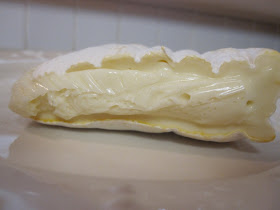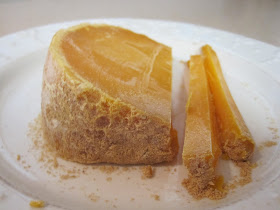Saint Andre is a triple cream soft-ripened cow's milk cheese,
in the tradition of Brie and Camembert, made in Coutances, Manche department, in the Normandy region of France (as one site commented, "produced in the shadow of the mystical island of Mont Saint-Michel" - an advertisement that's good enough to get me to buy a wedge).
Extra cream, both sour and whipped sweet, is added to get the milk fat level up to about 75%. One site called it the "world's most famous triple cream cheese."
The maturing process is about 30 days. A wheel of Saint Andre is smaller and shaped much higher than Brie. It has a white edible, bloomy or moldy, rind (from Penicillium camemberti), which is not as smooth as the Brie rind.
I have read that the flesh is buttery and mild like Brie, but that as it ripens, the color turns more yellow than white and the cheese can start separating from the rind.
The flavor also becomes stronger and a little sharp. The Saint Andre we had was on the ripe side. You can see it was yellowish and the texture was not Brie-like at all. Instead of buttery or creamy, it was more the texture of Boursin or very heavy egg whites and a little crumbly.
It was extremely rich, with a salty tang, and after we had it a few days, it got just an after-thought of a blue taste, a very mild level. But it just melted in my mouth, which made the texture of it un-nerving. It is highly perishable and should be eaten within a week of purchase. I would like to taste it when it is young, but I loved having it very ripe. The texture was so different for this type of cheese that eating it was a real experience.





















































